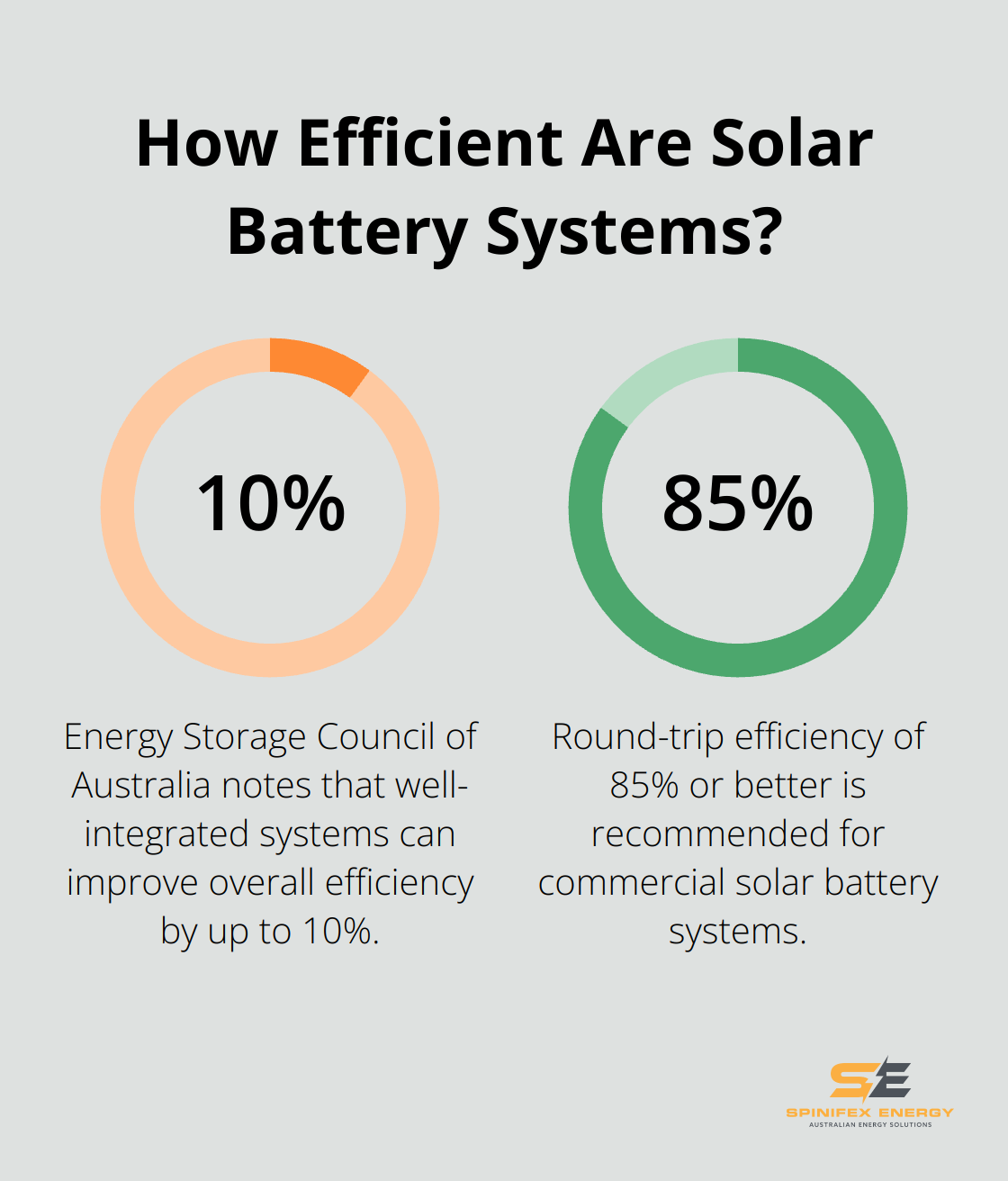Commercial solar batteries are revolutionizing how businesses manage their energy needs. These powerful storage systems work in tandem with solar panels to maximize renewable energy use and reduce reliance on the grid.
At Spinifex Energy, we’ve seen firsthand how commercial solar batteries can slash energy costs and provide crucial backup power during outages. In this post, we’ll explore the benefits of these systems and help you choose the right solution for your business.
How Commercial Solar Batteries Work
The Basics of Commercial Solar Batteries
Commercial solar batteries are powerful energy storage systems that capture and store excess electricity generated by solar panels. These batteries allow businesses to maximize their use of renewable energy, reduce reliance on the grid, and maintain power during outages.

At their core, commercial solar batteries function as large-scale versions of rechargeable batteries used in everyday devices. However, engineers design them to store and discharge much larger amounts of electricity. Lithium-ion batteries are the most common type used in commercial settings due to their high energy density, long lifespan, and decreasing costs.
When solar panels produce more electricity than a business needs, the excess energy flows into the battery for storage instead of returning to the grid. Businesses can then use this stored energy when solar panels aren’t producing electricity (e.g., at night or during cloudy days).
Integration with Solar Panel Systems
The integration of solar batteries with existing solar panel systems is relatively straightforward. The process typically involves the installation of an inverter (if not already present) and the battery system. The inverter converts the DC electricity produced by solar panels into AC electricity used by most businesses, and vice versa for storing energy in the battery.
The Clean Energy Council provides information on the compliance activity from the Approved Solar Retailer program, including details on complaints and other relevant data.
Types of Commercial Solar Batteries
While lithium-ion batteries dominate the market, businesses have other options available:
- Lead-acid batteries: These batteries offer a more traditional and less expensive option, but they have a shorter lifespan and lower energy density compared to lithium-ion batteries.
- Flow batteries: These batteries use liquid electrolytes and are known for their long cycle life and ability to provide power for extended periods. Larger commercial applications often use flow batteries.
- Sodium-ion batteries: This newer technology gains traction due to its use of more abundant materials and potential for lower costs.
Lithium-ion batteries remain the most suitable option for most commercial clients due to their balance of performance, lifespan, and cost. However, the best choice depends on specific business needs, budget, and energy consumption patterns.
As businesses continue to embrace renewable energy solutions, the role of commercial solar batteries becomes increasingly important. The next section will explore the numerous benefits these systems offer to businesses, from cost savings to increased energy independence.
Why Commercial Solar Batteries Are Game-Changers
Dramatic Cost Reduction
Commercial solar batteries revolutionize energy management for businesses. These powerful systems slash energy costs significantly. Companies store excess solar energy during the day and use it during peak demand periods when electricity rates soar. This practice, known as peak shaving, results in substantial savings on energy bills.

By maximising the use of solar energy, businesses can reduce their reliance on the grid, lower their operational costs, and contribute to a more sustainable future. This reduction in energy expenses impacts a company’s bottom line positively, freeing up resources for other critical areas.
Uninterrupted Business Operations
Power outages can cripple businesses, leading to lost productivity, damaged equipment, and potential revenue loss. Commercial solar batteries provide a reliable backup power source, ensuring operations continue even during grid failures.
Companies that invest in a solar battery system mitigate this risk and maintain operations during critical periods (such as unexpected blackouts or scheduled maintenance).
Enhanced Solar Investment Returns
Businesses that have already invested in solar panels can significantly increase their return on investment by adding a battery storage system. Solar batteries allow companies to use nearly all the energy their panels produce, rather than sending excess power back to the grid.
This increased utilization translates to greater energy independence and improved financial returns on solar investments.
New Revenue Streams
Some regions offer opportunities for businesses with solar batteries to participate in demand response programs or provide grid services. These programs allow companies to sell excess stored energy back to the grid during peak demand periods, creating an additional revenue stream.
This additional income helps offset the initial cost of the battery system and provides ongoing financial benefits.
Commercial solar batteries transform a business’s energy strategy through cost reduction, operational continuity, maximized solar investments, and potential new revenue streams. The next chapter will explore how to choose the right commercial solar battery system for your specific business needs.
Selecting Your Ideal Commercial Solar Battery
Assessing Your Energy Profile
The first step in selecting a commercial solar battery involves understanding your business’s energy consumption patterns. You should analyze your electricity bills from the past 12 months to identify peak usage times and overall consumption. This data forms the foundation for determining the appropriate battery size and type.

A manufacturing facility operating 24/7 will have different storage requirements compared to a 9-to-5 office space. The Australian Energy Market Operator (AEMO) provides valuable insights into energy consumption patterns across various industries, which can serve as a benchmark for your analysis.
Determining Optimal Battery Capacity
After you assess your energy profile, you can determine the ideal battery capacity for your needs. A common guideline suggests sizing your battery to cover 50-80% of your daily energy consumption. However, this can vary based on your specific goals and budget.
If your primary aim is to reduce peak demand charges, a smaller battery focused on covering those specific hours might be more cost-effective. Alternatively, if you’re aiming for maximum energy independence, a larger system capable of storing excess solar production for nighttime use would be more appropriate.
The Clean Energy Council reports that the average commercial solar system size in Australia has steadily increased, with many businesses now opting for systems over 100kW (indicating a growing recognition of the benefits of larger solar and battery installations).
Compatibility and Integration
When you add a battery to an existing solar system, compatibility becomes paramount. Not all inverters are battery-ready, and some may require additional components or upgrades. If you’re installing a new solar-plus-storage system, consider integrated solutions designed to work together seamlessly.
You should also consider future expansion. Choose a system that allows for modular growth, so you can add more battery capacity as your energy needs evolve or as your budget allows.
The Energy Storage Council of Australia emphasizes the importance of system integration, noting that well-integrated systems can improve overall efficiency by up to 10%.
Critical Features for Commercial Batteries
When you evaluate commercial solar batteries, pay close attention to these key features:
- Cycle life and warranty: Look for batteries with high cycle life (5000+ cycles) and robust warranties (10+ years).
- Depth of discharge (DoD): A battery’s DoD indicates the percentage of the battery that has been discharged relative to the overall capacity of the battery.
- Round-trip efficiency: This measures how efficiently the battery can store and release energy. Seek systems with 85% efficiency or better.
- Monitoring and management systems: Advanced software can optimize battery performance and provide valuable insights into your energy usage.
- Safety features: Ensure the battery system has robust safety measures (including thermal management and fire suppression systems).
The CSIRO’s battery testing center provides independent performance data on various commercial battery systems, which can be an invaluable resource when comparing options.
Final Thoughts
Commercial solar batteries transform the energy landscape for businesses across Australia. These powerful systems offer multiple advantages, including significant cost reductions and enhanced energy independence. Companies can slash their electricity bills and reduce grid reliance by storing excess solar energy for use during peak demand periods.

The role of battery storage in future-proofing businesses cannot be underestimated. With rising energy prices and growing grid stability concerns, commercial solar batteries provide a path to energy security and cost predictability. They also position businesses at the forefront of the clean energy transition, enhancing their sustainability credentials.
We at Spinifex Energy specialize in helping businesses navigate the complex world of commercial solar batteries. Our team of experts provides tailored energy consulting services to optimize electricity expenses. We handle the complexities of energy management, allowing you to focus on your core business activities while enjoying reduced costs and increased sustainability.

